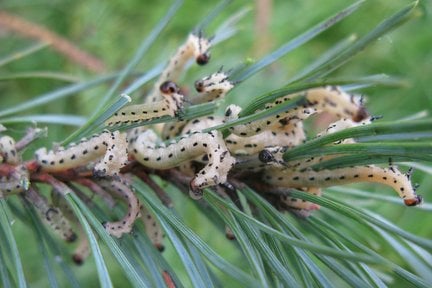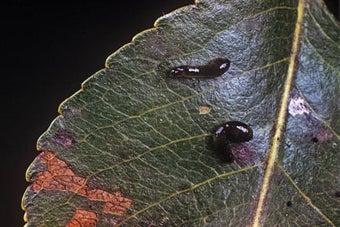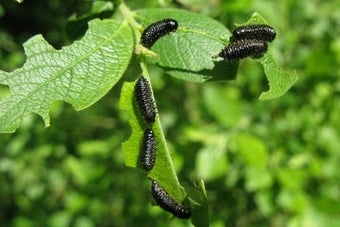
Quick facts
Common name - Pine sawfly and fox-coloured sawfly
Scientific names - Diprion pini and Neodiprion sertifer
Plants affected - Pine (Pinus)
Main symptoms - Caterpillar-like larvae defoliate plants
Most active - Spring-Summer
What are pine sawflies?
Sawflies are a group of insects in the suborder (Symphyta) of the Hymenoptera (bees, ants and wasps). There are about 500 species of in Britain. They have caterpillar like larvae that feed on plant material and are named after the saw like egg laying organ used by females to lay eggs in plant material. Adults can come in a range of colours many are black, green orange or striped yellow and black. Most are small (< 1 cm) but some species such as the Birch sawfly (Cimbex femoratus) can be over 2 cm long. Several species can be found in gardens and are part of the a healthy garden will support. More information can be found at The Sawflies of Britain and Ireland webpages.
Adult pine sawfly (Diprion pini) are 10 mm long brown winged insects, The larvae reach up to 25 mm long and are pale green in colour with a brown head and black markings.
Fox-coloured sawfly (Neodiprion sertifer) is 7-9 mm long and pale orange-brown. The larvae reach 25 mm in length are a dirty green colour with a black stripe and a black head.
The larvae of both species of sawfly feed in groups on the needles of pines during the spring and summer.
Symptoms
Large populations of pine larvae can cause considerable defoliation of trees, whilst this is unusual in gardens when it occurs it can affect the growth of the trees.

Management
Sawflies can be a part the a heathy garden supports
- Where possible tolerate populations of
- Encourage predators and other natural enemies of sawfly in the garden, such as birds and ground beetles
- Check plants regularly from spring for the presence of larvae and remove by hand where practical
Biology
Pine adults are active in spring and the females lay eggs in slits they make with an egg laying organ (ovipositer) in the needles. The larvae hatch after a few weeks and feed in groups on the needles. These larvae will lift their abdomen off the plant in a group as a defensive posture when disturbed. The larvae are usually fully grown by July where they spin brown cocoons on the foliage or on the ground beneath the plant. New adults emerging in July or August and can produce a second generation of larvae that feed in late summer and autumn. The autumn generation spins cocoons in soil or leaf litter, pupating in the following spring.
Fox-coloured sawfly adults are active in late summer and early autumn and lay eggs on the needles. The eggs overwinter and hatch in spring. The larvae feed in groups which will raise their abdomens when disturbed. In late June the fully grown larvae drop to the soil to pupate in an oval cocoon. This species has one generation a year.

















